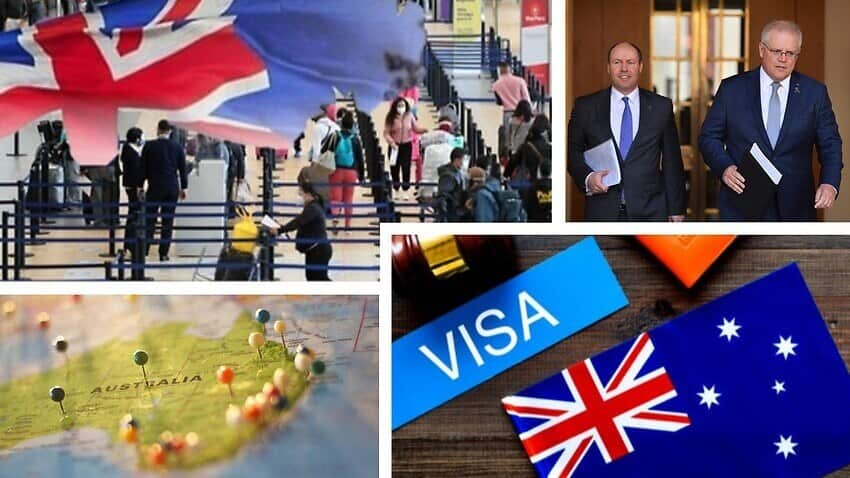Highlights
- Australia’s work visa categories fall under general skilled migration and employer-sponsored visas
- These visas allow workers to live and work in Australia on both temporary and permanent basis
- International students and skilled workers rely on visa subclasses 189, 190, 491, 186, 482, and 494 for permanent residency (PR)
Every year hundreds of thousands of skilled migrants choose to live and work in Australia because of the lifestyle and employment opportunities offered.
Though Australia has maintained its migration cap at 160,000 for a few years now, the country still manages one of the more sought-after skilled migration programs in the world.
A large part of this program is made up of the skilled stream which allows foreign workers or migrants to live and work in Australia on permanent as well as temporary work visas.
The most popular work visa categories fall under general skilled migration and employer-sponsored visa arrangements that often lead to pathways for permanent residency. Melbourne-based registered migration agents Ranbir Singh and Navjot Kailay provide information on Australia’s most common work visas that offer permanent residency pathways on a direct and long-term basis.
Melbourne-based registered migration agents Ranbir Singh and Navjot Kailay provide information on Australia’s most common work visas that offer permanent residency pathways on a direct and long-term basis.

Source: Getty Images/FatCamera
PR pathways for Non-Employer Sponsored Visas:
Subclass 189 Skilled – Independent Visa
The Points-tested stream of Skilled – Independent visa allows highly skilled workers who are not sponsored by an employer, State or Territory of Australia, or family member to live and work permanently in Australia.
Those wishing to apply for this visa under the Points-tested stream must first obtain a positive skills assessment for their nominated occupation, and then lodge an Expression of Interest. If this is successful, the applicant will be invited to lodge a visa application.
Migration agent Ranbir Singh says that this is one of the most desired direct PR visas but the 'chances of securing an invite' have slimmed during the post-COVID scenario.
“Only 6500 spots were allocated to this visa stream in 2020-21. But we hope things will get better after the situation with the coronavirus is controlled,” he says.
"The visa authorities are currently focussing on applicants that are mainly working in the critical skills sector, notably in the health care sector."
To avail this visa, one must be under the age of 45, have an occupation that is included on the Medium and Long-term Strategic Skills List (MLTSSL), have their skills assessed, and prove competency in English skills. Subclass 190 Skilled – Nominated Visa
Subclass 190 Skilled – Nominated Visa

Source: Getty Images/stanciuc
The Skilled – Nominated visa allows highly skilled workers who are nominated by an Australian State or Territory to live and work permanently in Australia.
To apply for this visa, the applicant must first obtain a positive skills assessment for their nominated occupation and then lodge an Expression of Interest.
If the applicant is successful in receiving a nomination from a State or Territory, they will be invited to lodge an application for this visa.
Mr Singh says in terms of the PR pathways, the state nominated permanent visa is considered ‘as good as the 189-visa category’.
“These visas have been availed at a great success rate in the past. Compared to the 189 categories, the only extra condition is that the applicants need to meet the state requirements and show commitment towards working in that specific region,” he says. Subclass 491 - Skilled Work Regional (Provisional)
Subclass 491 - Skilled Work Regional (Provisional)

Source: Pixabay
The subclass 491 visa allows invited skilled workers to live and work in specified regional areas of Australia for up to five years.
For availing this opportunity, one must first obtain a positive skills assessment for their nominated occupation and then lodge an Expression of Interest. If successful, the applicant will be invited to lodge a visa application.
“This is a temporary visa where you need to work with the employer in a regional area for 3 years and meet the minimum income requirement each year before you become eligible for the Subclass 191 or in the other words, permanent residency,” he adds.
“The 491 visa is not a preferred choice among the skilled migrants. But some workers find it easier to avail due to its relatively lower eligibility requirements.”

Source: Getty Images/Drazen_/Nicola Katie
PR pathways for Employer-Sponsored Visas
Migration agent Navjot Kailay provides information on various employer-sponsored visas including the 186, 482 and 494 visa categories that offer permanent residency pathways.
Subclass 186 - Employer Nomination Scheme
The purpose of the Employer Nomination Scheme (ENS) to allow Australian employers to fill highly skilled positions with suitably qualified migrants.
The scheme is designed to assist employers who are unable to fulfill their skilled Australian workforce needs from the local labour market.
Mr Kailay says this category offers direct PR but it does come with a lot of effort.
“It is a good opportunity, but it requires 3 years of post-qualification work experience which can be a challenge for many people,” he says.
“It also depends on the business which is seeking to employ you. The employer must have the capacity to retain you in a full-time position available for at least 2 years from the time your visa is granted.”
Mr Kailay says the MLTSSL requirement and a salary of at least $53,900 per year are also associated with this visa category.

Source: Supplied by Danyal Syed
The Temporary Skill Shortage (TSS) visa allows employers to sponsor overseas workers to live and work in Australia on a temporary basis.
This visa is designed to assist employers who are unable to meet their skilled Australian workforce needs from the local labour market.
Mr Kailay says this opportunity is available for Medium-term and Short-term Streams where a temporary visa is available for either two or four years depending upon the nature of the skilled job.
“The pathway often leads to PR through 186 visa arrangement after 3 years of working with the designated employer,” he adds.
It is subjected to the relevant Australian conditions of employment and the Labour Market Testing (LMT), which dictates that the sponsor must have attempted to recruit a suitably skilled and qualified Australian to work in the nominated position."
This requires the sponsor to provide evidence that they have advertised the position within the last 4 months, for at least 4 weeks. Subclass 494 - Skilled Employer Sponsored Regional (Provisional) Visa
Subclass 494 - Skilled Employer Sponsored Regional (Provisional) Visa

Source: iStockphoto
The subclass 494 - Skilled Employer Sponsored Regional (Provisional) (SESR) visa allows employers to sponsor overseas workers to live and work in regional Australia on a temporary basis.
“It leads to permanent residency through 191 visa category after 3 years of working with the designated employer in a regional area,” Mr Kailay says.
“The position to be filled must be on either the MLTSSL or the Regional Occupation List (ROL), it must be on a full-time basis in a designated regional area and likely to exist for the next 5 years.”
Global Talent Independent (GTI) program
In addition to the employer-sponsored visas, Mr Kailay also explained the PR pathways through the
“It is a streamlined visa pathway aimed at attracting the world’s best and brightest migrants and high-income earners at the top of their field to work and live in Australia permanently,” he says.
It is the fastest way to avail permanent residency in Australia.
The pathway is aimed at attracting highly skilled migrants working in one of the seven designated ‘future-focused’ sectors: ag-tech, med-tech, space, fin-tech, energy and mining technology, cybersecurity, and data science.
To be eligible, the applicants must demonstrate the potential to earn a salary at or above the income threshold of $153,600 each year and have their application supported by a nominator of national reputation in the same field. According to the Department of Home Affairs, the most common permanent visas include some skilled work and family visas that allow you to remain in Australia indefinitely. To find a visa that suits your needs .
According to the Department of Home Affairs, the most common permanent visas include some skilled work and family visas that allow you to remain in Australia indefinitely. To find a visa that suits your needs .

Source: Getty Images/MicroStockHub
Click on the player above to listen to the interviews with registered migration agents Ranbir Singh and Navjot Kailay.
Disclaimer: This content is for general information purposes only, and should not be used as a substitute for consultation with professional advisors.









